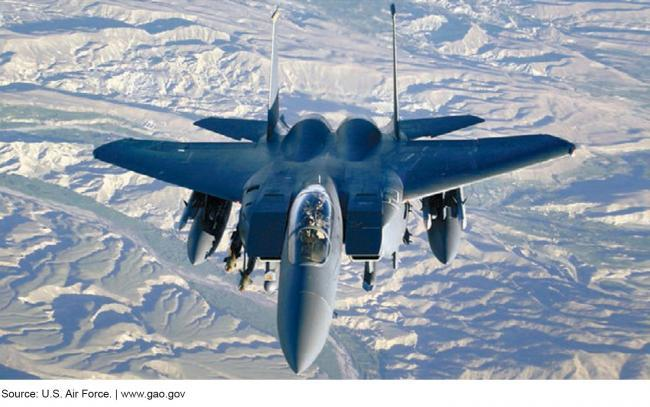Ready Aircrew Program: Air Force Actions to Address Congressionally Mandated Study on Combat Aircrew Proficiency
Fast Facts
In 2016, we reported that Air Force combat aircrew training requirements—such as the flight and simulator hours required for proficiency—needed a comprehensive review of their effectiveness. Congress then required the Air Force to commission an independent study of training requirements and to report how it planned to respond to any report recommendations.
The Air Force generally agreed with the study’s 9 recommendations on training but did not explain how it would specifically address them in its 1-page response to Congress. The Air Force said it did not have the resources for additional efforts and considers these recommendations “closed.”

Military jet in flight
Highlights
What GAO Found
A July 2018 RAND report—commissioned by the Air Force—addressed the statutory requirements of the National Defense Authorization Act (NDAA) for Fiscal Year 2017 to review and assess the Air Force's Ready Aircrew Program and make recommendations for ways to improve it. The Ready Aircrew Program establishes minimum annual training requirements for combat aircrew. RAND's report, entitled Independent Review and Assessment of the Air Force Ready Aircrew Program , made nine recommendations to improve its management:
1. Leverage internal expertise to implement measures for proficiency.
2. Invest resources to design data collection and storage solutions that facilitate analysis and readiness reporting.
3. Document the Ready Aircrew Program Tasking Memorandum development process in Air Force instruction supplements and ensure that the process incorporates squadron-level input and feedback.
4. Establish a more explicit and formal link between proficiency and Ready Aircrew Program requirements.
5. Document training quality to support requests for training resources.
6. Identify the conditions under which Ready Aircrew Program requirements, including mission types, can be accomplished.
7. Consider changing how Ready Aircrew Program requirements affect the Flying Hour Program.
8. Invest in data systems to correct data collection and assess deficiencies.
9. Leverage the Air Force Research Laboratory's performance data work and invest in added analysis to produce enterprise-wide proficiency metrics.
The nine RAND recommendations aligned with two GAO recommendations made in 2016 to comprehensively assess the assumptions underlying the annual aircrew training requirements and develop a process to collect data to assess the effectiveness of the training.
The Air Force's August 2018 one-page report to Congress included three broad actions in response to RAND's recommendations. The Air Force planned to
build training matrices to help commanders assess their units' effectiveness,
establish common data architecture through the Air Force's Chief Data Officer–led effort, and
evaluate aspects of the Ready Aircrew Program to increase lethality and improve readiness as the Air Force shifts to executing the mandates of the 2018 National Defense Strategy.
The Air Force, however, did not explain how these three efforts would specifically address the nine recommendations. Air Force officials said that, though they generally agreed with RAND's recommendations, the Air Force lacked the resources to fully implement them beyond actions that were underway prior to the RAND report, and considers all recommendations as “closed.” In part due to its not fully implementing RAND's recommendations, the Air Force has not fully addressed GAO's two recommendations. Fully implementing GAO's recommendations would better position the Air Force to ensure its aircrews receive effective training to achieve a range of missions.
Why GAO Did This Study
In September 2016, GAO reported that annual combat aircrew training requirements delineated in the Air Force's Ready Aircrew Program might not address pilot training needs, and that the Air Force did not systematically evaluate the effectiveness of its training. As a result, Congress included a provision in Section 351 of the NDAA for Fiscal Year 2017 for the Air Force to commission an independent review of its Ready Aircrew Program, report on actions it planned to take in response to any recommendations, and provide an estimate of any resources required.
Section 351 also included a provision for GAO to assess the Air Force report. This report examines whether (1) the independent review conducted by the RAND Corporation addressed statutory requirements to review and assess the Ready Aircrew Program, and (2) the Air Force has reported on completed or planned actions to implement the RAND report recommendations.
To address these objectives, GAO reviewed the RAND and Air Force reports on the Ready Aircrew Program, assessed the study against generally accepted research standards, and interviewed officials at RAND, Air Force Headquarters, and the Air Combat Command.
Recommendations
GAO is not making any new recommendations in this report but restates the need to fully implement GAO's two 2016 recommendations. In comments on a draft of this report, DOD did not concur with the two 2016 recommendations. GAO maintains that the Air Force should implement both recommendations. recommendation. GAO will consider these in its annual recommendations follow-up.
